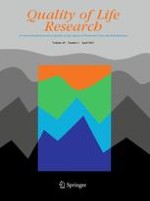01-04-2011 | Brief Communication
Measuring health-related quality of life in Kashin–Beck disease using EQ-5D
Gepubliceerd in: Quality of Life Research | Uitgave 3/2011
Log in om toegang te krijgenAbstract
Purpose
To assess health-related quality of life in patients with Kashin–Beck disease (KBD) in China.
Methods
A total of 684 participants from endemic areas of the Shaanxi province in China were recruited through a multistage stratified random sampling. Amongst those, 368 participants were diagnosed with KBD while the rest of 316 were non-KBD participants. Differences between KBD and non-KBD groups were analysed for the percentage of reporting any problems in each of EQ-5D five dimensions, EQ-5D index scores and visual analogue scale (VAS) scores.
Results
KBD patients have a higher percentage of reporting any problems in each of EQ-5D dimension than non-KBD participants and a general population in Beijing. The most affected dimension is pain/discomfort, followed by mobility, anxiety/depression, and usual activities, and self-care being the last. The mean EQ-5D index and VAS scores for KBD patients are significantly lower than those of non-KBD participants.
Conclusion
This study is the first attempt to measure the health-related quality of life in KBD patients. The results of the study show that KBD has a severe impact on patients’ health-related quality of life as measured by EQ-5D. It particularly causes great problems in the dimensions of pain/discomfort, mobility and anxiety/depression.
